Search:
Powered by
Website Baker
Major General Andrew Jackson Smith |
| Posted by The Muse (themuse) on Aug 12 2014 |
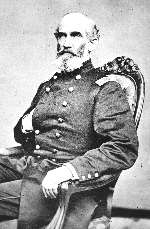 Andrew Jackson Smith was born on April 28, 1815 in Bucks County, Pennsylvania. His father was an American war veteran, having served in the Revolutionary War and the War of 1812. So it seemed natural for A. J. Smith to attend the United States Military Academy at West Point. He graduated in 1838 and was commiss
Andrew Jackson Smith was born on April 28, 1815 in Bucks County, Pennsylvania. His father was an American war veteran, having served in the Revolutionary War and the War of 1812. So it seemed natural for A. J. Smith to attend the United States Military Academy at West Point. He graduated in 1838 and was commiss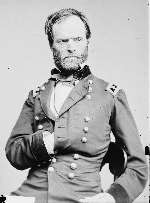 ioned a Second Lieutenant in the First Dragoons, United States Army. During the War with Mexico, Smith spent most of his time in California.
ioned a Second Lieutenant in the First Dragoons, United States Army. During the War with Mexico, Smith spent most of his time in California.
When the American Civil War began, Smith was appointed a Colonel of Cavalry Volunteers. At the request of Major General Henry W. Halleck, Smith received a promotion to Brigadier General and assigned to Halleck’s command in the Department of the Mississippi as the Chief of Cavalry. By the fall of 1862, Smith was in Kentucky, commanding of the First Division in the Federal Army of Kentucky.
By the end of 1862, Brigadier General A. J. Smith was participating in Grant’s operations against Vicksburg. Smith had brought the First Division from Kentucky and was assigned to Sherman’s 13th Army Corps in Grant’s Army of the Tennessee.
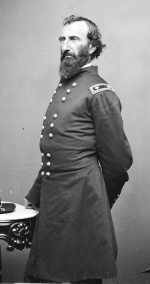 In January 1863, Smith’s First Division, the 13th Army Corps was now in the Army of the Mississippi and under the command of Major General John A. McClernand. Smith’s First Division was part of the left wing in McClernand’s expedition against Fort Hindman at Arkansas Post. McClernand was supported by Rear Admiral David D. Porter, who was in command of a naval flotilla that included three City Class Ironclad Gunboats, the Baron DeKalb, the Louisville, and the Cincinnati. The Confederates surrendered the fort on January 11, 1863, but it was a costly victory for Smith’s First Division, suffering close to half of the total Federal casualties.
In January 1863, Smith’s First Division, the 13th Army Corps was now in the Army of the Mississippi and under the command of Major General John A. McClernand. Smith’s First Division was part of the left wing in McClernand’s expedition against Fort Hindman at Arkansas Post. McClernand was supported by Rear Admiral David D. Porter, who was in command of a naval flotilla that included three City Class Ironclad Gunboats, the Baron DeKalb, the Louisville, and the Cincinnati. The Confederates surrendered the fort on January 11, 1863, but it was a costly victory for Smith’s First Division, suffering close to half of the total Federal casualties.About a week later, all the Federal forces in Arkansas were attached to the Army of the Tennessee with Major General Ulysses S. Grant in command. Brigadier General A. J. Smith’s division was renamed the Tenth Division, still in the 13th Army Corps commanded by Major General McClernand. The Tenth Division fought in the Battle of Port Gibson in May 1863. Two weeks later, Smith led the Tenth Division in the Battle of Champion Hill on May 16 and then again at the Big Black River Bridge the next day. After these two fights, the Confederates withdrew into their Vicksburg entrenchments.
After the fall of Vicksburg, Grant ordered A. J. Smith to take command of the Federal forces at Columbus, Kentucky. Smith found himself in command of the Sixth Division in the 16th Army Corps in the Military Division of the Mississippi. But seven months later in February 1864, Smith found himself ordered to the field again, this time to participate in Major General William T. Sherman’s expedition to Meridian, Mississippi. Smith found himself in command of the Third Division in the Major General Stephen S. Hurlbut’s 16th Army Corps in the Army of the Tennessee.
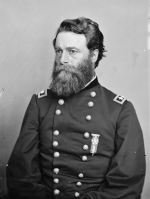 Then on March 8, 1864, Sherman ordered Brigadier General A. J. Smith to take command of a detachment of 10,000 men from the 16th Army Corps and the 17th Army
Then on March 8, 1864, Sherman ordered Brigadier General A. J. Smith to take command of a detachment of 10,000 men from the 16th Army Corps and the 17th Army Corps. Called the Right Wing of the 16th Army Corps, Smith’s command consisted of two divisions of infantry. The First Division was commanded by Brigadier General Joseph A. Mower. The Third Division was commanded by Colonel David Moore (Colonel William T. Shaw replaced Moore as commander of the Third Division on July 31, 1864). 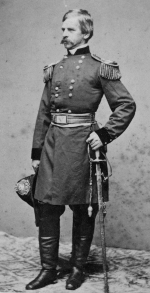 They were headed for Louisiana to support Major General Nathaniel P. Banks in the Red River Campaign. Smith reached the mouth of the Red River with his detachment on March 11, 1864. The plan was to link up with Major General Nathaniel P. Banks upriver in Alexandria, Louisiana. But first they needed to neutralize the Confederate garrison at Fort De Russy. With support from Rear Admiral David D. Porter, Smith moved upriver to attack, capturing the enemy garrison on March 14. Smith sent part of his forces upriver to occupy Alexandria while the remainder stayed to destroy Fort De Russy. Banks did not reach Alexandria with his command until March 26.
They were headed for Louisiana to support Major General Nathaniel P. Banks in the Red River Campaign. Smith reached the mouth of the Red River with his detachment on March 11, 1864. The plan was to link up with Major General Nathaniel P. Banks upriver in Alexandria, Louisiana. But first they needed to neutralize the Confederate garrison at Fort De Russy. With support from Rear Admiral David D. Porter, Smith moved upriver to attack, capturing the enemy garrison on March 14. Smith sent part of his forces upriver to occupy Alexandria while the remainder stayed to destroy Fort De Russy. Banks did not reach Alexandria with his command until March 26.
 They were headed for Louisiana to support Major General Nathaniel P. Banks in the Red River Campaign. Smith reached the mouth of the Red River with his detachment on March 11, 1864. The plan was to link up with Major General Nathaniel P. Banks upriver in Alexandria, Louisiana. But first they needed to neutralize the Confederate garrison at Fort De Russy. With support from Rear Admiral David D. Porter, Smith moved upriver to attack, capturing the enemy garrison on March 14. Smith sent part of his forces upriver to occupy Alexandria while the remainder stayed to destroy Fort De Russy. Banks did not reach Alexandria with his command until March 26.
They were headed for Louisiana to support Major General Nathaniel P. Banks in the Red River Campaign. Smith reached the mouth of the Red River with his detachment on March 11, 1864. The plan was to link up with Major General Nathaniel P. Banks upriver in Alexandria, Louisiana. But first they needed to neutralize the Confederate garrison at Fort De Russy. With support from Rear Admiral David D. Porter, Smith moved upriver to attack, capturing the enemy garrison on March 14. Smith sent part of his forces upriver to occupy Alexandria while the remainder stayed to destroy Fort De Russy. Banks did not reach Alexandria with his command until March 26.Sherman had made it clear to the War Department that he would recall Smith’s detachment in thirty days to prepare for the spring campaign east of the Mississippi River. On April 3, Sherman send a dispatch to Smith, ordering him to return to Vicksburg in order to get ready for the spring campaign. Smith was to head for Grenada, Mississippi in an attempt to find and destroy the Confederate forces commanded by General Nathan Bedford Forrest.
But because of Banks’ delays, Smith was finding it hard to extract his command from Louisiana. On April 8 Banks advanced on Mansfield, Louisiana where he was attacked by Confederate forces under the command of Major General Richard Taylor. Taylor’s men overwhelmed the Federals, who withdrew back towards Pleasant Hill. The next day, Smith had reinforced Banks and deployed his divisions across the road to Mansfield. The Confederates attacked, but this time were repulsed and had to withdraw to Mansfield. Even so, Banks ordered a retreat downriver to Grand Ecore, Louisiana. As Banks continued his retreat down the Red River, Smith’s command acted as the army’s rear guard. It was slow going and Smith did not reach the mouth of the Red River until May 20. Smith moved up the Mississippi River to Vicksburg, arriving on May 23, 1864. His 30-day detachment had lasted 74 days.
So A. J. Smith was finally able to extricate himself from the Red River Campaign. Surely he would be on his way soon to reunite his command with Sherman’s Army of the Tennessee.
Stay tuned ...
Last changed: Aug 12 2014 at 1:47 PM
Back